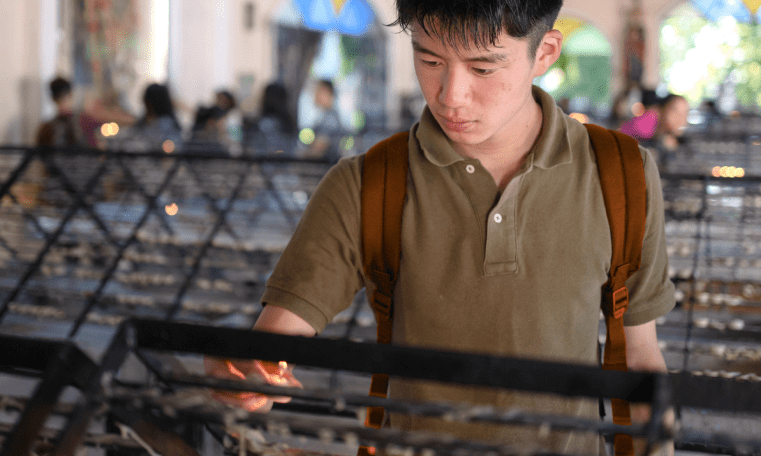
Undas, a time-honored tradition that’s changing with the times
For Filipinos, Undas is a time to remember our loved ones. But, it’s so much more than that. As much as it is a day for paying respects to our dear departed, Undas is also a celebration of life. Our memories of Undas are when the family reunites, praying together, eating delicious feasts, and making time for play! You could say it’s about spending time with the family, bringing together those who are living to visit the resting places of those who have passed on – it’s a family reunion.
When you hear the word “Undas,” what comes to mind? We all know it’s a two-day celebration - All Saints Day and All Souls Day – a practice handed down to us by the Spaniards. But as Filipinos, we have also made it our own, and here’s why.
It’s all about family
In contrast to Christmas, which is often a more intimate family affair, Undas brings the whole clan together.
At first glance, Undas looks like one big party. There are balloons, tents, food, drinks, food stands, vendors, and even karaoke. The only catch is the party is in a graveyard.
“Uy, kumusta ka na?” “And laki mo na, dati ganito ka lang kaliit, oh.” These are common phrases you might hear. Everyone missed their family and is excited to see their baby cousins and pamangkins. Families can bond with each other again.
It is a time when we can once again satisfy our cravings for our titos’ and titas’ homecooked specialties because you simply cannot find that exact taste anywhere else. And lumpiang shanghai, pansit, and adobo cannot be off the menu!
You would hear ghost stories left and right. People love scaring and teasing kids. But it is also a time when everyone gathers for prayer, wishing peace to those who have passed on.
It’s not a boring day for kids, either. Roaming around and collecting wax dripped from candles is part of a Filipino’s childhood. They would even compete to see who could build the biggest ball of wax.
With everyone in the family gathered around, it is the perfect time for grandparents to pass on old stories and customs to the young ones, like pag-mano sa tito, tita, lolo, and lola.

Undas is changing with time
While Undas is a time-honored tradition, some practices remain, but new ones are being created. As more towns across the country become urbanized, our experience of Undas changes.
- Visits have become more somber and shorter as columbariums have become more popular.
- To make the most of the extended holiday, many families visit cemeteries before the large crowds arrive, then proceed to their holiday destinations.
- The advent of BPOs has made the Undas experience more practical and intimate. Unable to take a break for this occasion, candle lighting and quick prayers at the closest chapel have become customary;
- While some have made it a day of remembrance by attending a virtual mass instead.

Preparing for a fun, safe and memorable Undas
The Undas season had office employees scurrying to file for leave ahead of their coworkers. Families are coordinating arrangements about when to commemorate and travel. Individuals have reserved planes and bus tickets in advance. Media outlets are running distinctive Undas stories, like gravestone artwork, daily life inside cemeteries, and the final resting places of famous figures - intriguing accounts not found on any other time of year.
The truth is Filipinos' experiences of Undas differs from one another. It depends whether they are visiting a public cemetery, a private park, a nicho, mausoleum or columbarium. Some visit at exactly November 1, however; this varies. Some earlier while others, later.
But they all have one thing in common. It all begins with planning the essentials ahead of time – lodging, meals, and travel schedules. People are cleaning and repainting nichos or mausoleum in advance. Families are planning their menu and sleeping arrangements. Often, Filipinos lay out a “banig” or a mat, and more recently–inflatables and they sleep side-by-side which also brings families closer. Probably the most important thing of all is the journey to get there. Like finding ways to beat the traffic and catching the earliest and fastest transportation available.

General reminders to keep in mind
Because this is the first time since COVID19 that government restrictions have been lifted, there might be more people than you expect. It is important to plan for a safe, fun, and memorable Undas so here are a few reminders:
- Leaving home – Secure windows and doors. Unplug all the appliances and turn off all the lights. Double-check if you turned off the gas before leaving. Is a neighbor helping you look out?
- Travel – If you’re driving, ensure that your car is in good condition. Join car groups on social media for travel advice. Waze your route to beat the traffic. If you are commuting, pack lightly and store your valuables in a safe place. Leave early and avoid rush hours. Mid-morning is when families “dagsa”, so plan ahead.
- Getting around – Have a designated area with a landmark where you can meet when you get lost. It might be difficult to find a signal with so many people in one location. And remember, don’t step on other family’s nicho!
- Protect yourself from COVID-19 and other airborne diseases – Never let your guard down and always wear masks in public. Wash or disinfect your hands often and remind your family members and guests of the health and safety protocols.
- Ready for rain or shine – Prepare a tent or any form of shade. Bring umbrellas and if possible, your things should be easy to carry in case heavy rains pour. Wear mud-safe footwear. November is the start of Amihan season, and we don’t expect heavy downpours. But then again, who knows?
Keep in mind that these are only general reminders. Check your local cemeteries and government offices for specific guidelines being implemented. For instance, large public cemeteries do not allow vendors inside, so make sure to pack enough food before you enter.
Undas is the season to honor our dear departed, but it also provides instant clan bonding moments– a time to relive, reconnect, and learn more about our family. It reminds us of how blessed we are to have our bigger family by our side. Most of all, it’s an excellent way to pass on time-honored traditions to the next generations and celebrate life the Pinoy way.






